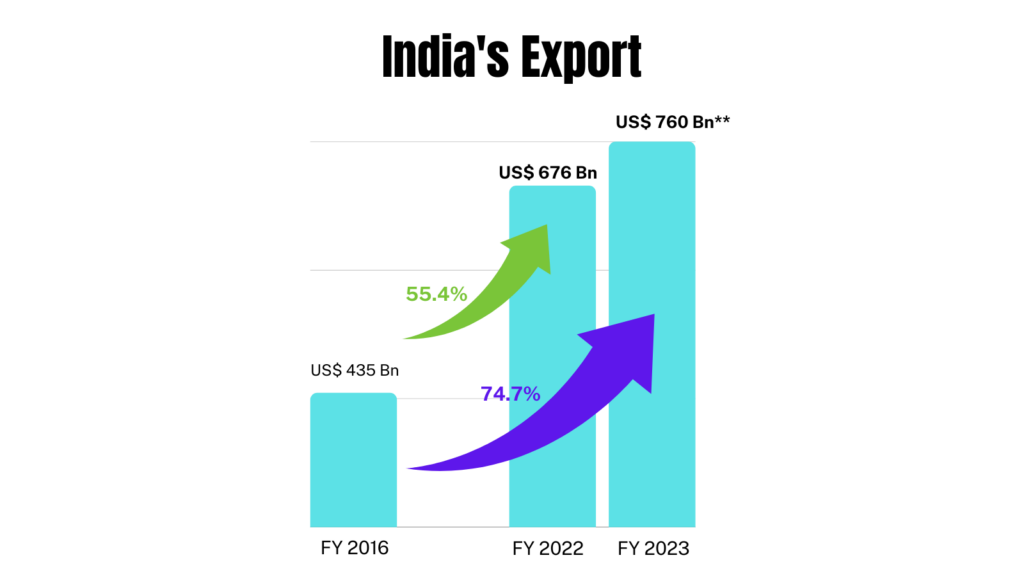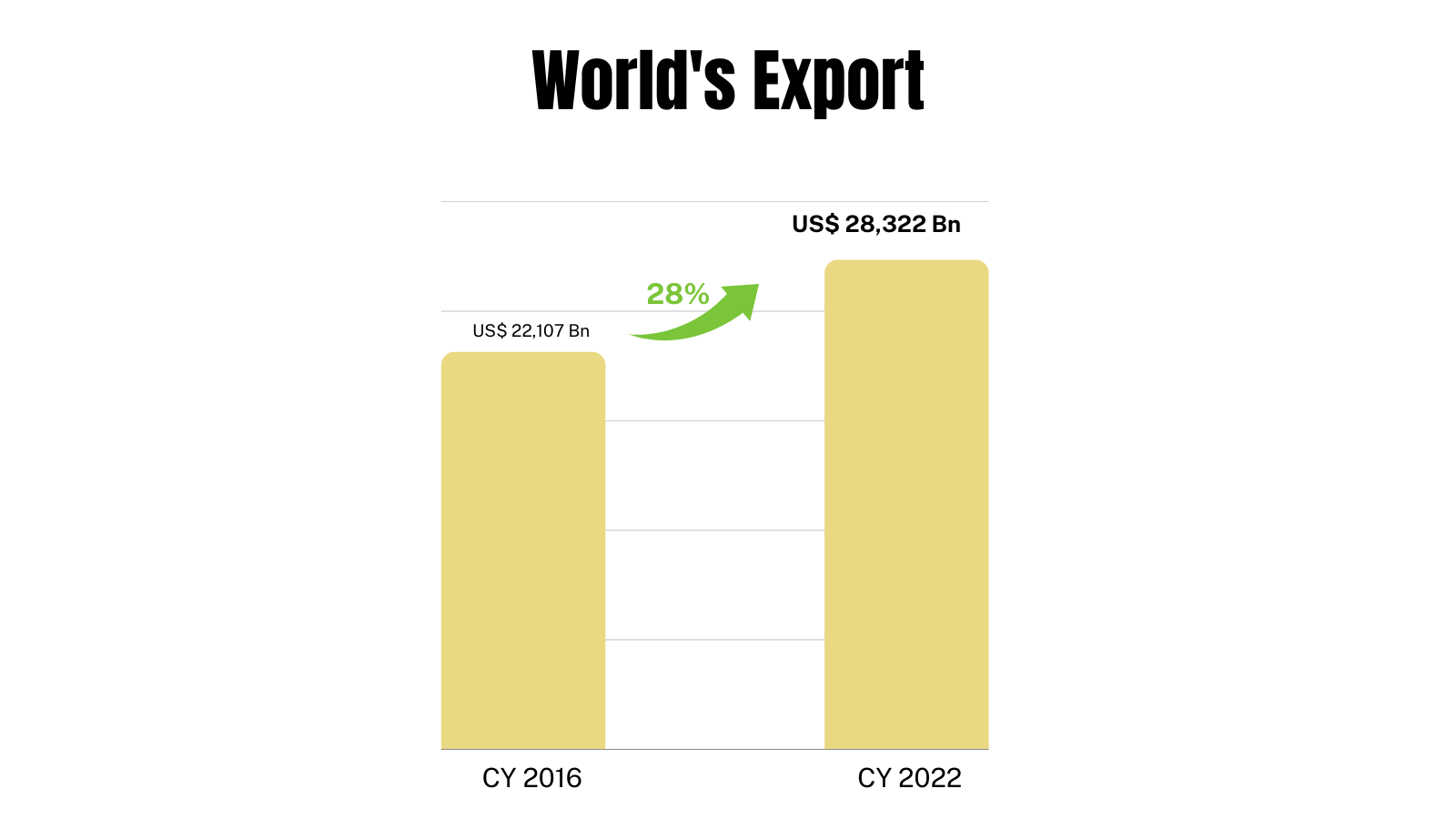Merchanting trade of restricted and prohibited items under export policy would now be possible.
It takes two to tango. In the context of India’s external commercial engagement, a robust $760 billion worth outward shipment of merchandise goods and services and the opening up of a world market in the wake of slowdown in developed economies are expected to power India’s dream of a USD 2 trillion export bounty, as being planned through the new Foreign Trade Policy 2023. The policy based on duration, dynamism, decentralisation, direction and disaster proofing of countries’ facing currency crisis could be a game changer to put India at a leadership position in the global exports map as it moves the country towards reduced transaction costs, internationalization of rupee, capacity building of MSMEs and creating trade resilience. Policymakers see room to increase India’s share in world exports from the current level of 1.8% in merchandise exports and 4% in service exports.

While the Government has been driving home India’s potential for the country to grow manifold given its manufacturing and service sector base, a visionary FTP to spearhead the expansion of India’s export footprint has been long in the making with prolonged discussion involving multiple stakeholder consultations. Now with a dynamic and open-ended FTP that will cater to emerging needs, the Government has opened up the space to capture every opportunity for export and utilise effectively, including a massive concentrated outreach with the world both sector-wise and country-wise within the next 5 months during India’s G20 presidency, as strategized by Commerce Minister Piyush Goyal. “Amid global headwinds of trade uncertainty, slowdown in advanced economies and inflation, the new pragmatic FTP will encourage exporters and will help to address global markets at a time when supply chain resilience is being prioritized by importing nations,” says Chandrajit Banerjee, Director General CII.
While there will be continuity of time-tested schemes facilitating exports in the new FTP, hereafter, the revisions shall be done as and when required, based on regular feedback from trade and industry to streamline processes and respond to emerging situations. Chairman of Engineering Exports Promotion Council Arun Kumar Garodia highlights the change in mindset. “The FTP is a very adventurous policy which removes the sunset clause of five years which had the challenge of waiting for a single amendment and change in the policy. They have opened up the policy which gives space to talk to the Government for any desired change and that gets implemented. We are optimistic that the Government target of exports of USD 1 trillion for goods and USD 1 trillion for services will be fulfilled,” Garodia told The Sunday Guardian.
At the actual policy execution level, the FTP has further rationalised the Export Promotion Capital Goods (EPCG) scheme which allows import of capital goods at zero customs duty for export production. The PM MITRA scheme for the textile and apparel sector will be eligible to claim benefits under EPCG. Similarly, to boost manufacturing, battery electric vehicles of all types, vertical farming equipment, wastewater treatment and recycling, rainwater harvesting system and rainwater filters and green hydrogen will now be eligible for reduced export obligation requirement under EPCG scheme.
In an innovative move, the FTP 2023 will enhance exports by enabling merchanting trade from India. Merchanting trade involves shipment of goods from one foreign country to another foreign country without touching Indian ports, involving an Indian intermediary. Merchanting trade of restricted and prohibited items under export policy would now be possible. This will be subject to compliance with RBI guidelines, and will allow Indian entrepreneurs to convert certain places like GIFT city etc. into major merchanting hubs as seen in places like Dubai, Singapore and Hong Kong. “Third party export is a wonderful idea,” points out Ajay Sahai, DG of Federation of Indian Export Organisations.
“Assuming in wheat I have developed a market. Now if I am not supplying wheat, my buyer will go away. Now with this relaxation coming in, I will take the wheat from Australia and supply it to Indonesia. So my market will continue,” says Sahai.
With India placing more emphasis on the “export control” regime as its integration with export control regime countries strengthens, there is wider outreach and understanding of SCOMET (Special Chemicals, Organisms, Materials, Equipment and Technologies) among stakeholders. Hence the FTP regime is being made more robust to provide access of dual-use high end goods and technologies to Indian exporters while facilitating exports of controlled items/technologies under SCOMET from India.
Considering the effectiveness of some of the ongoing schemes like Advance Authorisation and EPCG, these are being upgraded with process re-engineering and technology enablement to facilitate ease of doing business for exporters. Duty exemption schemes for export production will now be implemented through regional offices in a rule-based IT system environment, eliminating the need for manual interface. Subhrakant Panda FICCI President finds the thrust laid on technology interface for approvals under various schemes, in sync with the thrust on enhancing ease of doing business.
“The infrastructure and e-governance initiatives charted out in this policy along with the recently launched National Logistics Policy will enable our exporters to reduce the trade and logistics costs,” says Panda.
The new Foreign Trade Policy has a special focus on developing “Districts as Export Hub” with measures to identify export worthy products and services at the district level through a state export promotion committee and district export promotion committee. District specific export action plans will be prepared outlining the strategy to promote export of identified products and services. “Currently, a few states account for the major proportion of exports and encouraging exports from districts would encourage rural entrepreneurship and help spread export benefits to the grassroots across the country. The initiative for capacity building of small exporters would help them to move up in the value chain,” says Banerjee.
Export promotion will also involve stronger collaboration with states and districts. Four new towns, namely Faridabad, Mirzapur, Moradabad and Varanasi have been designated as Towns of Export Excellence (TEE) which will have priority access to export promotion funds under the Market Access Initiative scheme and common service provider benefits for export fulfilment, which is expected to boost exports of handlooms, handicrafts, and carpets. As e-commerce exports have potential in the range of USD 200 to USD 300 billion by 2030, FTP 2023 paves way for establishing e-commerce hubs and related elements such as payment reconciliation, book-keeping, returns policy, and export entitlements. As a starting point, the consignment wise cap on e-commerce exports through courier has been raised from Rs 5 lakh to Rs 10 lakh. There are extensive outreach and training activities on the anvil to build capacity of artisans, weavers, garment manufacturers, gems and jewellery designers and onboard them on e-commerce platforms. Such efforts will help in further value-addition thereby making Indian products and services more competitive across the globe.

